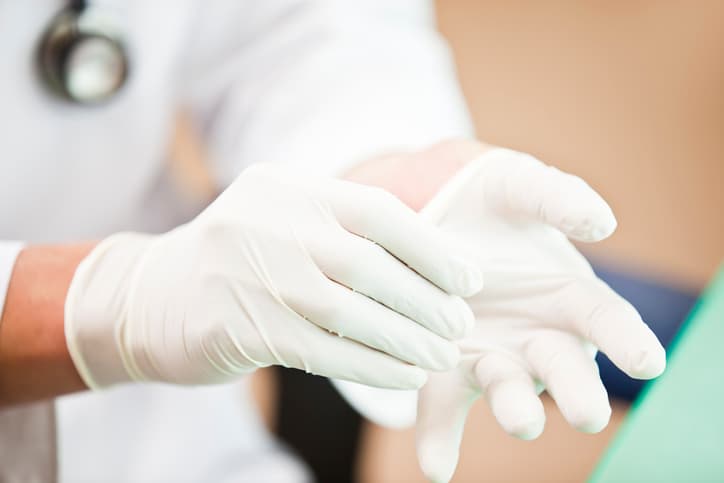 , also known as rubber or natural latex, is derived from the milky sap of the rubber tree, Hevea brasiliensis. Latex can be found in many household products and also in many medical and dental supplies including gloves, masks, and syringes.Latex allergy develops in some individuals after repeated exposure to products containing natural rubber latex. As is the cause in any allergy, a latex allergy arises when an individual’s immune system overreacts to an otherwise harmless substance (called an allergen).In this case, the immune system overreacts when a latex-containing dental device or supply — such as gloves — comes into contact with the mucous membranes (the eyes, nose, or mouth) of a susceptible individual. Even the powder used on latex gloves can contain the latex proteins and become airborne when the gloves are removed, causing upper airway allergic reactions or asthma symptoms in susceptible people.
, also known as rubber or natural latex, is derived from the milky sap of the rubber tree, Hevea brasiliensis. Latex can be found in many household products and also in many medical and dental supplies including gloves, masks, and syringes.Latex allergy develops in some individuals after repeated exposure to products containing natural rubber latex. As is the cause in any allergy, a latex allergy arises when an individual’s immune system overreacts to an otherwise harmless substance (called an allergen).In this case, the immune system overreacts when a latex-containing dental device or supply — such as gloves — comes into contact with the mucous membranes (the eyes, nose, or mouth) of a susceptible individual. Even the powder used on latex gloves can contain the latex proteins and become airborne when the gloves are removed, causing upper airway allergic reactions or asthma symptoms in susceptible people.
What Causes Latex Allergy?
The exact cause of latex allergy is unknown, but repeated exposure to latex and rubber products is thought to trigger symptoms.
What Can Happen as a Result of an Allergic Reaction to Latex?
There are three types of allergic reactions to latex:
- Irritant contact dermatitis. The least threatening type of latex reaction, this nonallergenic reaction may result in dryness, itching, burning, scaling, and lesions of the skin.
- Allergic contact dermatitis. This is a delayed reaction to additives used in latex processing, which results in the same type of reactions as irritant contact dermatitis (dryness, itching, burning, scaling, and lesions of the skin), but the reaction is more severe, spreads to more parts of the body, and lasts longer.
- Immediate allergic reaction (latex hypersensitivity). This is the most serious allergic reaction to latex. Symptoms include runny nose with hay fever-like symptoms, conjunctivitis (pink eye), cramps, hives, and severe itching. Rarely, symptoms may progress to a life-threatening condition known as anaphylaxis — which is associated with such symptoms as a sudden drop in blood pressure, and increased pulse, tremors, chest pain, difficulty breathing/wheezing, and tissue swelling.
What Should I Do If I Think I’m Experiencing a Latex Allergic Reaction?
If you experience severe symptoms of a latex allergic reaction, call your dentist, doctor, or 911 immediately, or go to the nearest emergency room.
How Is Latex Allergy Diagnosed?
A skin or blood test can diagnose a latex allergy. Skin testing for latex allergy should only be done with the close supervision of an allergy specialist because of the risk of severe reactions.
In addition, a person may be diagnosed with a latex allergy if they have experienced signs or symptoms of an allergic reaction (skin rash, hives, eye tearing or irritation, wheezing, itching, difficulty breathing) when exposed to latex or natural rubber products.
What’s the Treatment for a Latex Allergy?
Allergic reactions to latex may be treated by removal of the latex product and drug treatment according to the type of symptoms developing. If the symptoms are irritant contact dermatitis, antihistamine and/or corticosteroid drugs may be enough to treat symptoms. Severe reactions should be treated with epinephrine, intravenous fluids, and other support by a hospital or emergency personnel. Be sure to contact your doctor before taking any medication.
If you have a latex allergy, it is important for you to wear a medical alert bracelet and carry an emergency epinephrine syringe. Epinephrine is the treatment used for severe allergic reactions.
There is no cure for latex allergy, so the best treatment for this condition is prevention. Besides the foods already mentioned in this document, there are other foods that might trigger a latex-like allergic reaction in people with latex allergy. If you suffer from a latex allergy, avoid these foods:
- Peaches, plums, and nectarines
- Grapes, strawberries, and cherries
- Wheat and rye
- Potatoes
- Melons
- Papayas
- Hazelnut
- Pineapple
- Celery
- Figs
Note: Not all people who have these food allergies will also have latex allergies.
What Precautions Should I Take Before Visiting My Dentist?
If you have a known latex allergy, call your dentist’s office at least 24 hours before your scheduled appointment. Your dentist and his or her staff should have a latex-free protocol that they follow for patients with latex allergies. They will also make a note of your allergy in your medical record.
